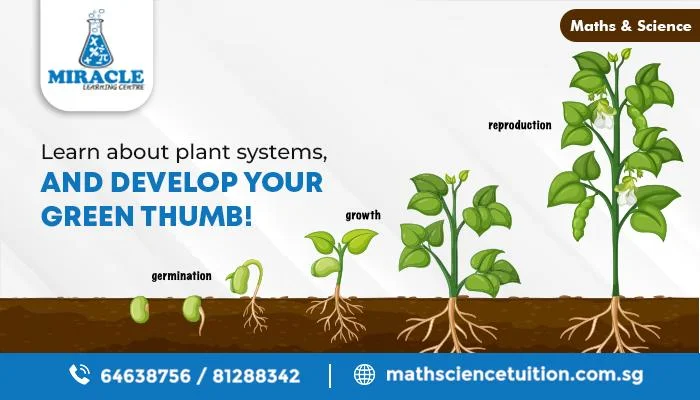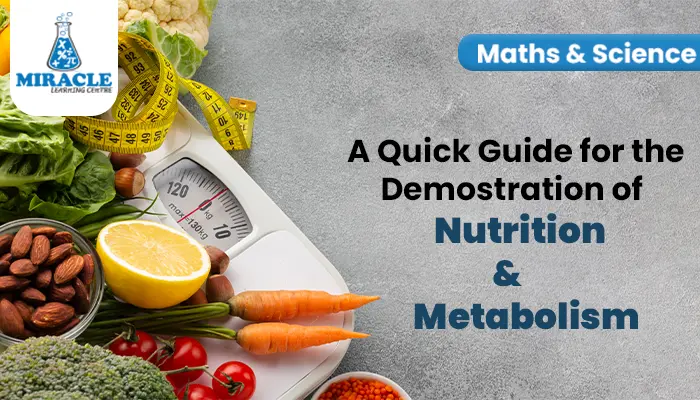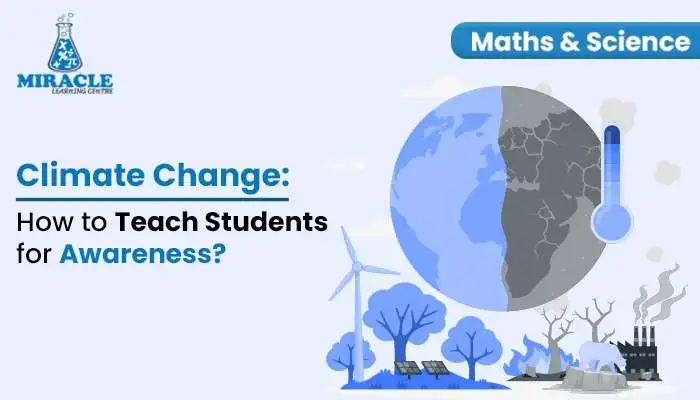Plants, the emerald marvels that grace our planet, are the very essence of life. Their significance reaches far beyond their green foliage and beautiful blossoms. As the primary producers in ecosystems, plants convert sunlight into life-sustaining energy through photosynthesis. Unraveling the intricate systems that govern these remarkable organisms is not only a pursuit for botanists and scientists but a journey of discovery for all who depend on the oxygen they release and the nourishment they provide. At Science tuition of Miracle Learning Centre, we are passionate about unraveling the mysteries of the botanical world.
As the Best Science Tuition in Singapore, our mission is to instill in our students a deep understanding of plant systems and their profound impact on our environment. Through interactive and engaging tuition sessions, we explore the intricacies of plant anatomy, from their roots to leaves, flowers to fruits. Let us embark on a journey to discover the captivating realm of plants and foster a sense of wonder and appreciation for the natural world around us.
Plants:
Plants, belonging to the kingdom Planate, comprise a diverse group of multicellular organisms. Ranging from towering trees to tiny mosses, they inhabit various environments worldwide, from lush rainforests to arid deserts. Their ability to synthesize food from sunlight sets them apart from other living beings, making them the cornerstone of terrestrial ecosystems. Apart from their ecological significance, plants serve various other essential functions, such as providing shelter, medicinal compounds, and aesthetic beauty.
Let’s unravel the complexities of the plant kingdom and discover the fascinating aspects of their anatomy, physiology, and life cycles.
What is the Plant System?
The plant system refers to the collective arrangement of various organs and tissues that work harmoniously to support the plant’s survival and growth. These systems encompass both above-ground and below-ground structures and serve specialized functions. The primary plant systems include the root system and the shoot system. The root system anchors the plant, absorbs water and nutrients, while the shoot system performs photosynthesis, transpiration, and reproduction. Understanding these systems and their components is fundamental to grasp the remarkable abilities of plants to adapt and thrive in diverse environments.
At Miracle Learning Centre, we understand the significance of the plant system, which refers to the intricate arrangement of organs and tissues that sustain a plant’s growth and survival. Our science tuition focuses on unraveling the complexities of the plant kingdom, ensuring our students grasp the fascinating aspects of plant anatomy and physiology. By nurturing a deeper understanding of plants, we empower our students to appreciate their ecological importance and inspire them to become responsible stewards of the environment. Join us at the Best Science Tuition in Singapore to explore the wonders of plants together!
Parts of Plants:
Plants exhibit incredible diversity in their forms, and each part plays a vital role in their overall functioning. The main parts of a plant can be broadly categorized into the root system and the shoot system. The root system comprises roots responsible for anchoring the plant and absorbing water and minerals from the soil. On the other hand, the shoot system encompasses stems, leaves, flowers, and fruits, each with distinct functions that contribute to the plant’s life cycle and reproduction.
Let’s delve into the details of these fascinating plant components and uncover their significance in the plant kingdom.
1. Root System:
The root system constitutes the hidden foundation of a plant’s structure, buried beneath the soil. It is primarily responsible for anchoring the plant securely, preventing soil erosion, and absorbing water and nutrients. One excellent example of an extensive root system is that of a banyan tree.
Banyan trees possess aerial prop roots that grow from their branches towards the ground, eventually developing into new trunks. These roots provide additional support to the tree, allowing it to spread widely and thrive in various soil conditions. The root system serves as a lifeline, sustaining plants and facilitating their growth and development.
2. Shoot System :
The shoot system of a plant encompasses the visible, above-ground structures that play crucial roles in photosynthesis, reproduction, and transpiration. Stems, leaves, flowers, and fruits are all integral components of the shoot system.
a) Stems:
Stems form the backbone of the plant, providing structural support and acting as conduits for transporting water, nutrients, and photosynthetic products throughout the plant body. A classic example of a stem is found in bamboo plants. Bamboo stems are not only sturdy but also remarkably flexible, making them resilient against harsh weather conditions. Additionally, some stems, like the potato, can store nutrients, ensuring the plant’s survival during unfavorable periods. Stems come in various shapes and sizes, showcasing the diverse strategies plants employ to thrive in their environments.
b) Leaves:
Leaves are nature’s solar panels, capturing sunlight and transforming it into chemical energy through photosynthesis. These flat, green structures contain chlorophyll, the pigment responsible for absorbing sunlight. A well-known example of a leafy wonder is the maple leaf. Maple leaves have a distinctive shape with several lobes and vibrant colors in the fall. Leaves not only produce food for the plant but also regulate transpiration, a process vital for cooling and transporting nutrients. Their incredible diversity in size, shape, and texture makes leaves one of the most captivating aspects of plants.
c) Flowers:
Flowers are the embodiment of a plant’s reproductive prowess, attracting pollinators with their enchanting colors, enticing fragrances, and sweet nectar. One of the most cherished flowers is the rose, known for its beauty and symbolic value. Flowers facilitate the union of male and female gametes, leading to the formation of seeds and fruits. Each flower’s structure is intricately designed to ensure effective pollination, achieved through wind, water, or animals like bees, butterflies, or birds. The beauty and diversity of flowers have captivated human imagination, inspiring art, culture, and even scientific research.
d) Fruits:
Fruits are the ripened ovaries of flowers, encompassing seeds and serving as a vehicle for their dispersal. Fruits exhibit an incredible range of shapes, sizes, colors, and flavors, enticing various animals to consume and spread their seeds. A familiar example is the apple, providing a nutritious and delicious treat. Fruits ensure the survival and distribution of plant species across diverse habitats. Some fruits have evolved unique adaptations, such as burrs that cling to fur or feathers, ensuring long-distance dispersal. The evolution of fruits exemplifies the ingenious strategies plants employ to ensure their offspring’s success.
Classification of Plants:
The vast diversity of plants necessitates a systematic classification system to understand their relationships and unique characteristics. Plants can be classified based on reproduction, life cycle, and growth habitats, providing valuable insights into their adaptation and evolution.
Based on Reproduction:
Plants can be classified as angiosperms or gymnosperms based on their mode of reproduction. Angiosperms are flowering plants that produce seeds enclosed within fruits. Examples include roses, orchids, and tomatoes. Gymnosperms, on the other hand, bear seeds on the surface of cones or scales. Iconic gymnosperms include pine trees, cedars, and spruces. These distinct reproductive strategies showcase the ingenuity of plant evolution and have contributed to their widespread distribution across various ecosystems.
Based on their Life Cycle:
Plants can be divided into annuals, biennials, and perennials based on their life cycles. Annuals complete their life cycle, from germination to seed production, within one year. Marigolds and petunias are classic examples of annual plants. Biennials require two years to complete their life cycle, producing seeds in their second year, e.g., carrots and foxgloves. Perennials live for multiple years, with some surviving for decades or even centuries. Trees like oak and redwood, as well as perennial flowers like roses, lilies, and daffodils, exemplify this category.
Based on their Growth Habitats:
Plants can be classified based on their preferred growth habitats, such as aquatic, terrestrial, or epiphytic. Aquatic plants like water lilies and lotus thrive in water bodies, adapting to submerged or floating conditions. Terrestrial plants are the most common, growing on land in various environments, from deserts to rainforests. Epiphytic plants, like orchids and ferns, grow on other plants without harming them, utilizing their host for support while obtaining sunlight and nutrients from the air and rain. Understanding these classifications helps us appreciate the incredible adaptability and versatility of plants.
Life Cycle of a Plant:
A plant’s life cycle represents the sequence of stages it goes through, starting from seed germination, growth, reproduction, and eventually, the production of new seeds. Let’s explore the life cycle of a sunflower, a popular garden flower.
Seed Germination: A sunflower seed, nestled in the soil, receives the right conditions of moisture, warmth, and oxygen, initiating the germination process.
Seedling Stage: The germinated seed gives rise to a young seedling with tiny leaves, stems, and roots, as it pushes its way through the soil surface.
Vegetative Growth: The seedling continues to grow, developing more leaves, a stronger stem, and an extensive root system. It focuses on photosynthesis to build energy reserves.
Reproductive Stage: When the sunflower plant reaches maturity, it forms flower buds at the top of the stem. These buds bloom into vibrant yellow flowers.
Seed Production: Once pollination occurs, the flowers transform into seed heads, each containing hundreds of seeds. These seeds disperse to start the life cycle anew.
Science Tuition Helps Kids to Know About Plants:
Science tuition plays a pivotal role in enriching children’s knowledge and understanding of the fascinating world of plants. At Miracle Learning Centre, the best Science tuition in Singapore, we provide a nurturing environment where students can explore the wonders of the plant kingdom. Our expert tutors employ interactive and engaging teaching methods to instill a deep appreciation for plants, their systems, and ecological significance. Through hands-on experiments and comprehensive lessons, students gain valuable insights into plant anatomy, life cycles, and classification. With our guidance, young minds grow to become environmentally conscious individuals, ready to protect and preserve the precious resources of our planet.
Conclusion:
The world of plants is a captivating and essential aspect of our planet’s biodiversity. From their root systems firmly anchored in the soil to their flowers blossoming in a riot of colors, plants continue to mesmerize and sustain life on Earth. Understanding the intricacies of plant systems, their classification, and life cycles is not only informative but also empowers us to appreciate their contributions to the ecosystem.
At Miracle Learning Centre, we believe that the world of plants is both captivating and essential to our planet’s biodiversity. Through our best Science tuition in Singapore, we strive to nurture young minds and instil a deep appreciation for the wonders of the plant kingdom. Our interactive lesarning approaches and expert tutors guide students in understanding the intricacies of plant systems, their classification, and life cycles. Together, we can empower the next generation to become stewards of the Earth, valuing and preserving the invaluable resources that plants provide for a sustainable future.






